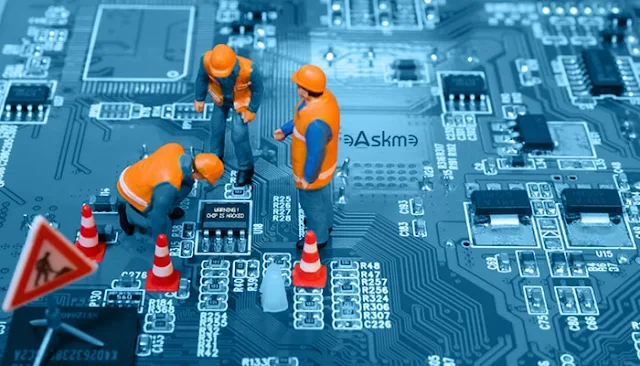However, many US manufacturers fail to perform regular maintenance on equipment. And this is hurting their equipment ROI, as well as production efficiency.
 |
| 8 Maintenance Best Practices For Longer Manufacturing Equipment Life: eAskme |
The truth is, most equipment maintenance is reactionary.
This needs to change in order for increased profitability, regardless of what manufacturing space you are in.
Manufacturing equipment maintenance could be as simple as servicing and/or replacing proximity sensors, or ensuring proper gear functionality.
To help, we compiled a list of eight maintenance best practices for longer manufacturing equipment life. Let’s dive in!
1. Get The Facts About Downtime Losses
In order to implement maintenance best practices for your manufacturing equipment, you need to first find out your downtime losses via data.The data on downtime can help you really nail down the scale of what lies ahead when it comes to a great maintenance plan
Data like machine downtime, machine failure, and spending on parts over the past year is what you can start compiling.
With this information in hand, you can see just how much downtime costs you per hour.
2. ROI For Equipment Maintenance
Once you know the average downtime cost per hour for your manufacturing equipment, you can do a bit of a projection on the ROI of an equipment maintenance plan.This means making projections on hourly cost of machine downtime and how greater maintenance can impact that based on ROI of maintenance.
Even a few percentage points of value can have a big time impact over the coming year.
3. What Are The Operational Variables?
This is a very important question to ask when it comes to maintenance best practices for longer manufacturing equipment life.The increase in productivity via better machine uptime and the savings a stronger maintenance operation can have can be part of knowing what your operational variables are.
For instance, knowing how to better handle critical spares, as well as implementing a work order SOP that can increase technician time to get to down equipment and fix the issue.
4. Look Manufacturer Into Tech Solutions
The digital age has ushered in great innovation, thus leading to many technological solutions for manufacturers.Having a tech solution in place can increase many of the operational variables success, outlined above.
For example, a computerized maintenance monitoring system (CMMS) can get work order information to technicians faster.
This improves the technicians ability to fix equipment faster.
5. Implement A Scheduled Preventive Maintenance Plan
With all the knowledge in your hands about your manufacturing equipment, it is time to implement a scheduled preventive maintenance plan.With your CMMS in place, you can easily monitor all your manufacturing equipment and track parts and spares effectively.
This will also help you implement your preventive maintenance plan.
You will also know what machines may need more preventive checks than others, like your older equipment for instance.
6. Deploy Predictive Tools In Your Manufacturing Operation
Preventive maintenance is only the beginning.Having that preventive checklist can make an impact, but the type of predictive tools you will have in place will also make a big difference.
Like electrical equipment in your manufacturing operation for instance.
This equipment can have overheating issues, so having preventive tools that monitor heat distribution in the equipment may help your technicians identify a problem before it becomes a serious issue.
You may even decrease downtime even more.
7. Have A Reliability Centered Maintenance (RCM) Plan Of Action
Having a Reliability Centered Maintenance (RCM) in place can decrease equipment downtime even more.This essentially gives you insight into machine capabilities and statuses.
There is no longer a need to move equipment from operational to down in order to do preventive maintenance checks.
This allows you to increase value in a cost-benefit way based on maintenance versus productivity.
8. Third-Party Technicians Are Still Needed
Maintenance is important.However, you may still need to bring in third-party technicians to get manufacturing equipment up and running to optimal levels.
After all, these are skilled technicians that have the expertise to get the job done faster.
You may even be able to bring in third-party technicians to train your in-house technicians to make maintenance more efficient.
Final Words:
The above eight maintenance best practices for longer manufacturing equipment life are only the tip of the iceberg.There are certainly other best practices you can employ for a streamlined manufacturing operation.
What maintenance best practices have worked best for you in the past?
We want to hear from you.
If you find this article interesting, don’t forget to share it with your friends and family.
Why?
Because, Sharing is Caring!
Don't forget to like us FB and join the eAskme newsletter to stay tuned with us.
You May Also Like These;













